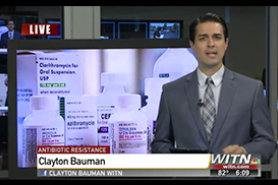Submitted by kmcochran on

If you've ever been to the doctor for unbearable sinus pain, or a sore throat, chances are you were prescribed antibiotics to help kick those ailments. But was that prescription necessary?
Dr. Paul Cook, Chief of Infectious Diseases at ECU's Brody School of Medicine, says that most outpatient infections seen by primary care doctors will resolve on their own.
For people admitted to hospitals, Cook says misuse of antibiotics is quite dramatic
"It's been estimated that 50% of antibiotic use in the hospital setting is inappropriate," said Cook.
So, what's the harm in getting a little extra help? It can be potentially fatal, if your body develops a resistance to antibiotics.
According to the CDC, there's at least 2-million illnesses and 23-thousand deaths caused by antibiotic resistant bacteria or fungi every year in the U.S.
In the simplest of terms, when a person takes antibiotics, the drug destroys both good and bad bacteria in an effort to fight infection. Drug resistant bacteria that were already there and survive the antibiotics now have the opportunity to expand. Those drug resistant bacteria also have the ability to pass resistances to other bacteria.
"I think to some extent it's (antibiotic resistance) already out of control, particularly in the hospital setting and the nursing homes," said Cook, "Resistant bacteria that are absolutely resistant to all the drugs that we have at our disposal and so we sometimes get patients who have infections here that we have very limited options and sometimes no options to treat these patients."
The hospital system is doing its due diligence though in fighting back.
Everyday, Dr. Cook and a team of 4 Vidant microbial use pharmacists are painstakingly vetting the charts of adult patients who have been on antibiotics for 24 to 72 hours.
"We review the case, we get our thoughts together, we talk to Dr. Cook about the case as well and what we do is we type up a note and leave a note in the chart and that note will flag for their provider," said Nicole Nicolsen, one of the pharmacists, "And they can see what our recommendations are, and then they are able to make the changes we suggest or they can call for further discussion if they want to talk more about it."
It's good stewardship that's also being practiced on the smallest of patients at the start of their lives.
"We are a part of the Perinatal Quality Collaboration of North Carolina, which we're part of a network of units," said Women's & Children's Nurse Practictioner, "There's 57 who are trying to decrease the risk and unnecessary use of antibiotics in neonates."
Gitzinger says the use of a sepsis calculator in recent years, which helps determine how much at risk for infection a baby is, has made a world of difference.
"We have seen a significant decrease in the number of antibiotics we are using on our newborns and the number of lab draws we are having to do on our newborns. So, we think it's good work and we're hoping to see a nice trend in the future," said Gitzinger.
And that decreased need for antibiotics now, means a better chance the drug will be effective later in life when you truly need it.
